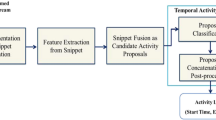Abstract
Human activity recognition (HAR) systems extract activities from observational data, such as sensor measurements from mobile devices, to provide for instance medical, fitness, or security information. A crucial initial step in these data analysis workflows is segmenting continuous numerical measurements into variable-sized segments that correspond to single activities. Human activity segmentation (HAS) enables downstream classification algorithms to label entire activities. Unfortunately, current time series segmentation (TSS) algorithms exhibit limited performance on multivariate sensor data due to complex temporal dynamics and irrelevant dimensions. This limits their applicability in HAR workflows. In this review, we provide a systematic benchmark of dimensionality reduction, model aggregation, and change point selection applied to the ClaSP TSS algorithm for real-world, multidimensional mobile sensing data. We evaluated the accuracy of the techniques in an experimental study using 250 data sets from the HAS challenge at ECML/PKDD and AALTD 2023. Our findings indicate that extending ClaSP for multivariate data, by aggregating internal representations, yields better results compared to reducing data dimensionality or selecting change points (CPs) from different channels. We report a new state of the art with 73% average accuracy on the challenge benchmark.
Access this chapter
Tax calculation will be finalised at checkout
Purchases are for personal use only
Similar content being viewed by others
References
Lara, O.D., Labrador, M.A.: A survey on human activity recognition using wearable sensors. IEEE Commun. Surv. Tutorials 15, 1192–1209 (2013)
Zhou, L., Fischer, E., Brahms, C.M., Granacher, U., Arnrich, B.: Duo-gait: a gait dataset for walking under dual-task and fatigue conditions with inertial measurement units. Sci. Data 10(1), 543 (2023)
Ahad, M.A.R., Antar, A.D., Ahmed, M.: Iot sensor-based activity recognition - human activity recognition. Intell. Syst. Ref. Libr. (2021)
Ermshaus, A., et al.: Human activity segmentation challenge @ ECML/PKDD’23. In: AALTD@ECML/PKDD (2023)
Ermshaus, A., Singh, S., Leser, U.: Time series segmentation applied to a new data set for mobile sensing of human activities. In: EDBT/ICDT Workshops (2023)
Truong, C., Oudre, L., Vayatis, N.: Selective review of offline change point detection methods. Signal Process. 167, 107299 (2020)
Gharghabi, S., et al.: Domain agnostic online semantic segmentation for multi-dimensional time series. DMKD 33, 96–130 (2018)
Ermshaus, A., Schäfer, P., Leser, U.: ClaSP: parameter-free time series segmentation. DMKD 37, 1262–1300 (2023)
Matsuyama, H., Hiroi, K., Kaji, K., Yonezawa, T., Kawaguchi, N.: Ballroom dance step type recognition by random forest using video and wearable sensor. In" UbiComp/ISWC, pp. 774–780 (2019)
Harańczyk, G.: Change points detection in multivariate signal applied to human activity segmentation. In: AALTD@ECML/PKDD (2023)
Huang, T.-J., Zhou, Q.-L., Ye, H.-J., Zhan, D.-C.: Change point detection via synthetic signals. In: AALTD@ECML/PKDD (2023)
Ermshaus, A., Schäfer, P., Leser, U.: Raising the ClaSS of streaming time series segmentation. PVLDB 17(8), 1953–1966 (2024)
Multivariate ClaSP Code, Extended Experiments and Raw Results (2024). https://github.com/ermshaua/multivariate-clasp
Ermshaus, A., Schäfer, P., Leser, U.: Window size selection in unsupervised time series analytics: a review and benchmark. In: AALTD@ECML/PKDD (2022)
Wang, C., Wu, K., Zhou, T., Cai, Z.: Time2State: an unsupervised framework for inferring the latent states in time series data. PACMMOD 1(1), 1–18 (2023)
Sadri, A., Ren, Y., Salim, F.D.: Information gain-based metric for recognizing transitions in human activities. PMC 38, 92–109 (2017)
Deldari, S., Smith, D.V., Sadri, A., Salim, F.D.: ESPRESSO: entropy and shape aware time-series segmentation for processing heterogeneous sensor data. In: IMWUT, vol. 4, pp. 77:1–77:24 (2020)
Tanaka, Y., Iwamoto, K., Uehara, K.: Discovery of time-series motif from multi-dimensional data based on mdl principle. Mach. Learn. 58, 269–300 (2005)
Fodor, I.K.: A survey of dimension reduction techniques. Technical report, LLNL, Livermore, USA (2002)
Zhu, Y., et al.: Exploiting a novel algorithm and GPUs to break the ten quadrillion pairwise comparisons barrier for time series motifs and joins. KAIS 54, 203–236 (2017)
Yeh, C.-C.M., Kavantzas, N., Keogh, E.: Matrix profile vi: meaningful multidimensional motif discovery. In: ICDM, pp. 565–574, IEEE (2017)
Demšar, J.: Statistical comparisons of classifiers over multiple data sets. JMLR 7, 1–30 (2006)
Author information
Authors and Affiliations
Corresponding author
Editor information
Editors and Affiliations
Rights and permissions
Copyright information
© 2025 The Author(s), under exclusive license to Springer Nature Switzerland AG
About this paper
Cite this paper
Ermshaus, A., Schäfer, P., Leser, U. (2025). Multivariate Human Activity Segmentation: Systematic Benchmark with ClaSP. In: Lemaire, V., et al. Advanced Analytics and Learning on Temporal Data. AALTD 2024. Lecture Notes in Computer Science(), vol 15433. Springer, Cham. https://doi.org/10.1007/978-3-031-77066-1_2
Download citation
DOI: https://doi.org/10.1007/978-3-031-77066-1_2
Published:
Publisher Name: Springer, Cham
Print ISBN: 978-3-031-77065-4
Online ISBN: 978-3-031-77066-1
eBook Packages: Computer ScienceComputer Science (R0)





